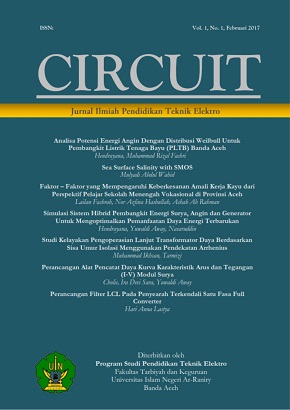Pengaruh Intensitas Cahaya Terhadap Nyala Lampu dengan Menggunakan Sensor Cahaya Light Dependent Resistor
DOI:
https://doi.org/10.22373/crc.v5i2.9719Keywords:
LDR Light Sensor, Light Intensity, Automatic Lighting, LampAbstract
The purpose of this research is to analyze the relationship between the intensity of light hitting the LDR to the resistance and the flame of the light. The research created an automatic lighting system, in which the lighting system was designed to turn on or off lights by light intensity. This research created automatic light controls using LDR light sensor. The LDR light sensor set is used as a switch that turns on or off a light automatically based on the recieved of intensity of light. By using the LDR components, it can design a series of light sensors for such items as outdoor light sensors, sleeping lights, garden lights, road lights that turn on at night and go out during the day automatically. The equipment used of the research were 2 test lamps, and done with 2 lighting sources, a natural source of lighting and an artificial source of lighting. From the research, it showed that the large light intensity affects the light flame by using LDR light sensor. It could be concluded that the greater of the light hitting intensity from the LDR surface was smaller than the value of the resistance and the flickering of the light. In contrast, the less light that affects the LDR, was the greater value of LDR resistance and lighter the light.
References
Abdullah, M. (2017). Fisika dasar II. Bandung: Institut Teknologi Bandung.
Fauzan, I. N. (2019). Analisis Sistem Kontrol Intensitas Cahaya Menggunakan Metode State Space. Yogyakarta: Universitas Negeri Yogyakarta.
Giancoli, D. C. (2001). Fisika Edisi Kelima Jilid 2. Jakarta: Erlangga.
Karimah, P. (2014). Sistem Kontrol Otomatis Menggunakan Sensor Cahaya dan Sesnsor Air Hujan pada Bangunan Rumah Tinggal. Palembang: Politeknik Negeri Sriwijaya.
Mitra Walidain, I. D. (2018). Perancangan Sistem Penerangan LED sebagai Sumber Cahaya pada Pengujian Modul Surya. Kitektro, 48.
Pribadi, A. (2020, Januari 09). Menteri ESDM. Retrieved from Menteri ESDM Web site: http://www.esdm.go.id
Sadwiko, P. (2004). Fisika Bangunan 1. Yogyakarta: Andi.
Santoso. (2016). Optimalisasi Penerangan dan Penyiraman Tanaman pada Taman Kota Berbasis Programable Logic Controller (PLC). Surabaya: Untag.
Sheha, A. I. (2017). Investigasi Permasalahan Performa Pencahayaan dalam Kelas Busana Butik SMKN 3 Metro terhadap Kenyamanan Visual Siswa. Jurnal Idealog, 316.
Simaremare, G. H. (2018). Rancangan Kontrol Lampu Automatis Menggunakan Rangkaian LDR. Medan: Universitas Sumatera Utara.
Sumardjito, I. W. (2015). Kajian Pencahayaan Campuran di Ruang Bengkel Kayu. Jurnal Inersia, 58-59.
https://teknikelektronika.com/rangkaian-lampu-tl-fluorescent-tl-led/ diunduh pada tanggal 20 Juli 2020
https://www.robotics-university.com/2014/10/light-dependent-resistor-ldr.html diunduh pada tanggal 20 Juli 2020.
https://radhityaken.wordpress.com/2014/10/10/diy-lampu-aquarium-tipe-hpl/, diunduh pada tanggal 03 Juni 2021.
https://www.ruparupa.com/blog/lampu-bohlam/ dinduh pada tanggal 03 Juni 2021.
Downloads
Published
Issue
Section
License
Authors who publish in CIRCUIT: Jurnal Ilmiah Pendidikan Teknik Elektro agree to the following terms:
- Authors retain copyright and grant the journal right of first publication with the work licensed under a Creative Commons Attribution-ShareAlike 4.0 International License (CC BY-SA 4.0) that allows others to share and adapt the work with an acknowledgement of the authorship and initial publication in this journal
- Authors are able to enter into separate, additional contractual arrangements for the non-exclusive distribution of the journal's published version of the work (e.g., post it to an institutional repository or publish it in a book), with an acknowledgment of its initial publication in this journal.
- Authors are permitted and encouraged to post their work online (e.g., in institutional repositories or on their website) prior to and during the submission process, as it can lead to productive exchanges, as well as earlier and greater citation of published work. (See The Effect of Open Acces)

